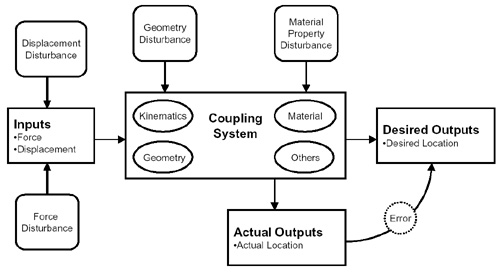Coupling Design Process: Design Analysis
The basic structure of the design analysis is shown in the following figure. Each external influence on the system is interpreted as a disturbance affecting the error output.

"Model of a Mechanical Coupling System." from Culpepper, Martin L. "Design and Application of Compliant Quasi-Kinematic Couplings", Ph.D. Thesis, Massachusetts Institute of Technology, Cambridge, MA, 2000.
While this diagram presents an ideal overview of the relationship between disturbances and error, a much more complex dependency exists. Error caused by the disturbances can be seperated into two main components: interchangability and repeatability. While interchangability is primarily influenced by manufacturing error, repeatability is complex combination of effects due to forces, displacements, geometry, and material properties. To design a exchangable kinematic coupling pairs, these effect of these disturbances must be predicted using design analysis. For example, useful design calculations include Hertzian contact analysis to predict stress and deformation at contact points, Monte Carlo simulations to predict the effect of varied manufacturing tolerances, and the effect of bolt torques and preloads. Examples of software tools for performing these designs are included on the Software Tools page. While these items can typically be built into a coupling model, solving the model may not always be straight forward. Culpepper's thesis describes the differing solution procedures required for modeling quasi-kinematic couplings in relationship to standard kinematic couplings. In addition, many parameters such as surface finish, material coatings, etc cannot be easily factored into a model, requiring experimentation.
Generalized design processes for the different coupling types can be found in the following case studies:
- Pin Joint - None currently available
- Elastic Averaging - Weber Thesis
- Planar Kinematic - Willoughby Thesis and Hart Thesis
- Quasi-Kinematic - Culpepper Thesis
- Kinematic - Slocum's Precision Machine Design and various papers (see Case Studies Page)